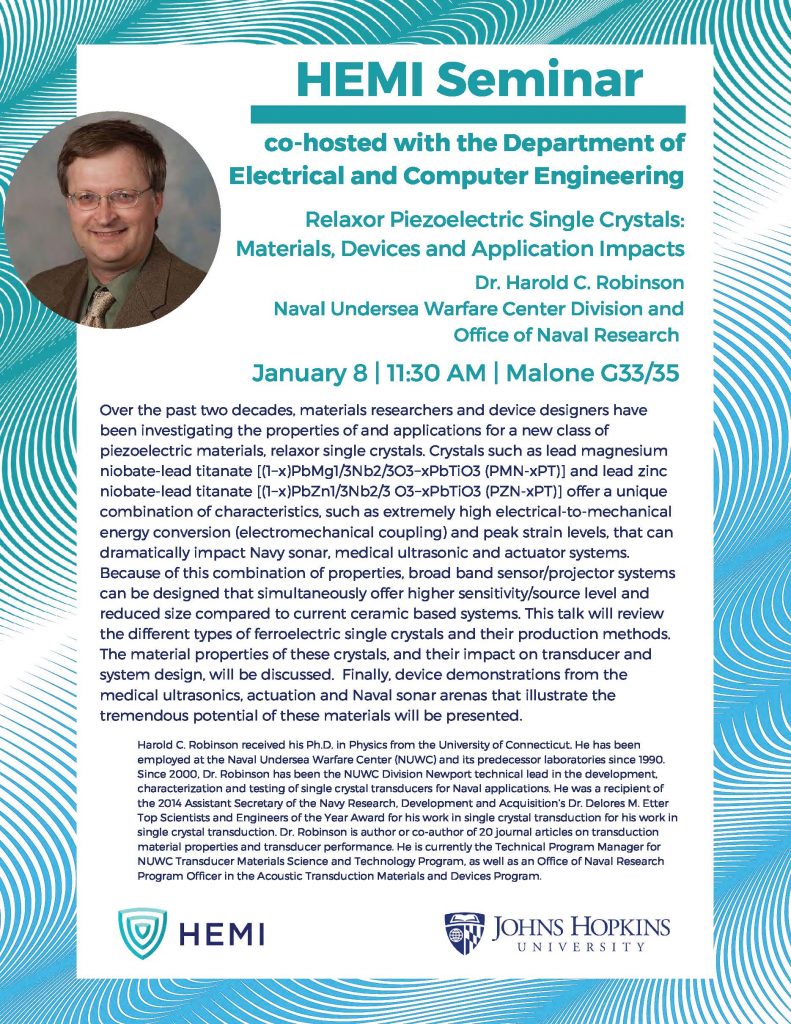January 8, 2018 @ 11:30 am - 12:30 pm
Event Navigation
Relaxor Piezoelectric Single Crystals: Materials, Devices and Application Impacts
Dr. Harold C. Robinson, Naval Undersea Warfare Center Division Newport, RI and Office of Naval Research, Arlington, VA
Over the past two decades, materials researchers and device designers have been investigating the properties of and applications for a new class of piezoelectric materials, relaxor single crystals. Crystals such as lead magnesium niobate-lead titanate [(1−x)PbMg1/3Nb2/3O3−xPbTiO3 (PMN-xPT)] and lead zinc niobate-lead titanate [(1−x)PbZn1/3Nb2/3 O3−xPbTiO3 (PZN-xPT)] offer a unique combination of characteristics, such as extremely high electrical-to-mechanical energy conversion (electromechanical coupling) and peak strain levels, that can dramatically impact Navy sonar, medical ultrasonic and actuator systems. Because of this combination of properties, broad band sensor/projector systems can be designed that simultaneously offer higher sensitivity/source level and reduced size compared to current ceramic based systems. This talk will review the different types of ferroelectric single crystals and their production methods. The material properties of these crystals, and their impact on transducer and system design, will be discussed. Finally, device demonstrations from the medical ultrasonics, actuation and Naval sonar arenas that illustrate the tremendous potential of these materials will be presented.
Harold C. Robinson received his Ph.D. in Physics from the University of Connecticut, Storrs, CT in 1990. He has been employed at the Naval Undersea Warfare Center (NUWC), Division Newport, and its predecessor laboratories since 1990. He has been a Principal Investigator in a variety of programs to determine transduction material properties under Naval sonar operating conditions, including electrostrictive ceramics and ferroelectric single crystals. Since 2000, Dr. Robinson has been the NUWC Division Newport technical lead in the development, characterization and testing of single crystal transducers for Naval applications. He was a recipient of the NUWC Excellence in Developmental Engineering Award in 2001 and the NUWC Excellence in Basic and Applied Research Award in 2007 and the 2014 Assistant Secretary of the Navy Research, Development and Acquisition’s Dr. Delores M. Etter Top Scientists and Engineers of the Year Award for his work in single crystal transduction for his work in single crystal transduction. Dr. Robinson is author or co-author of 20 journal articles on transduction material properties and transducer performance. He is currently the Technical Program Manager for NUWC Transducer Materials Science and Technology Program, as well as an Office of Naval Research Program Officer in the Acoustic Transduction Materials and Devices Program.





